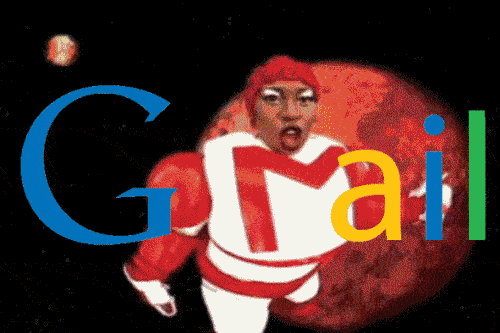Gmail: El gigante de los clientes de correo electrónico
Productos icónicos episodio 004
There’s no denying it: Gmail is huge.
With more than 1.2 billion monthly users, Google’s email client has grown significantly in the past 14 years and continues to dominate the market as one of the most-used email clients in the world.
But what makes Gmail such an iconic product? Let’s dive right in!

Una oferta increíble
Gmail tuvo un lanzamiento poco ortodoxo en 2004.
At a time when you paid for email services such as AOL and had to spend a ton of time searching for things in Outlook, Gmail completely revolutionized something that seemed so unexciting and routine: your email inbox. 📧
The press release announcing its launch was dated for April 1 — so many thought it was simply an April Fools’ Day joke.
It also didn’t help that some of the features of Gmail seemed unbelievable or, at the very least, too good to be true.
For example, Google offered 1 GB of free storage for each Gmail account — this was an amount of free storage space that was simply unheard of at this point in time. To put this in perspective: this was 500 times more storage than what Microsoft’s Hotmail offered (yes, Hotmail only gave you 2MB per account at the time). 😱

According to an interview with Gmail’s first product manager, Brian Rakowski, the April 1 launch was intentional. He said that the “ultimate April Fools’ joke was to launch something kind of crazy on April 1 and have it still exist on April 2.”
Gmail, con su increíble capacidad de almacenamiento, su interfaz fácil de usar, sus funciones de búsqueda y mucho más, cambió el juego del correo electrónico cuando se lanzó.
Google — and more specifically, Paul Buchheit — worked on Gmail for nearly three years before consumers could use it, and it was one of the first (if not the first) major cloud-based apps that could replace conventional PC software. 💽
Como Google aprovechó la tecnología web para crear su programa de correo electrónico desde el principio, hizo que Gmail pareciera un software real en lugar de una secuencia de páginas web mediante el uso de JavaScript.
There were instances in which the project could have just been abandoned altogether. Internally, Googlers were hesitant about the concept for a variety of reasons — so it’s incredible that it even became a product in the first place.
Free email inbox — meet AdSense
Google AdSense, el producto que escanea los mensajes para encontrar palabras clave que puedan utilizarse con fines publicitarios, se creó como prototipo mientras se creaba Gmail.
This tool sparked a debate around online privacy that still continues to this day (and is, of course, making headlines in recent months, thanks in part to things such as GDPR and the Cambridge Analytica scandal). 🔒
Pero esta era una de las ideas de Gmail en sus inicios: crear un sistema que analizara el texto de los correos electrónicos para que Google pudiera publicar anuncios junto a ellos.

According to Marissa Mayer herself, she almost prevented AdSense from ever coming to light. 😳
While she was initially against having ads in Gmail, Buchheit supposedly stayed up all night finishing the product and Mayer saw ads everywhere the next day — and they were well done and well targeted.
En pocas palabras, Buchheit había descubierto cómo escanear texto que coincidía con anuncios que ya habían sido comprados por clientes para consultas de búsqueda. Los cofundadores Larry Page y Sergey Brin vieron el producto poco después, y la empresa decidió aplicar la tecnología fuera de Gmail a otros sitios web.
This product is what we now know as AdSense, one of Google’s largest sources of revenue.
So, to put it simply: the work that made Gmail free by developing targeted ads next to it didn’t just change the business model for email services, it indirectly changed the business model for a lot of websites based on ads. 🆓
Reinventar Gmail
As you’ve probably already heard (or seen for yourself), Google recently released a new redesign of Gmail. 🤗
El correo electrónico sigue vivo y goza de buena salud, pero los clientes de correo electrónico se han sentido un poco estancados en los últimos años, por lo que el rediseño es un cambio bienvenido.
While it definitely has a more sleek and modern feel, following that of Material Design, it’s not a drastic difference from the last interface.
In fact, it almost looks like a combination of Gmail and Inbox (more on that in a minute). The new Gmail is clean, visual and packed with new features. 😍
Algunas de estas funciones son el aplazamiento de correos electrónicos para que vuelvan a aparecer en la bandeja de entrada horas o días después, sugerencias de respuesta inteligente en cada hilo de correo electrónico y la posibilidad de cargar widgets de otras aplicaciones en la parte derecha de la pantalla (para poder utilizar Tareas y Calendario mientras se está en un hilo de correo electrónico).

Beyond these new features, it’s apparent that Google is focusing more on both productivity and security.
Google Workspace, durante años, ha estado por detrás de Microsoft en cuanto a software de productividad en el lugar de trabajo, pero parece que Google está tratando de reclamar este espacio con su nuevo diseño y características.
In an interview with The Verge, Jacob Bank, lead product manager for Gmail, said that Google’s redesign was done with a focus on “making people safer and more productive,” both important aspects in appealing to business users.
It certainly looks like we’ll be seeing Gmail move even more toward a business focus in due time. 💼
Una experiencia web superrápida
One of Google’s main priorities when creating a new product is that it’s fast. User experience is at the heart of everything Google creates, and Gmail is no exception. 🏃
Even though they were the next big, exciting thing, web apps were slow and clunky around the time of Gmail’s launch. So, Google’s attention to a fast response time and high performance was a major development in the world of web apps.

Gmail, like all Google products, was built with the RAIL model in mind. RAIL is a “user-centric performance model that breaks down the user’s experience into key actions.”
Continúan explicando que cada aplicación web tiene cuatro aspectos específicos en su ciclo de vida, y el rendimiento de la aplicación encaja en ellos de diferentes maneras. Son: respuesta, animación, inactividad y carga.
This model helps designers and developers focus on what’s most important: making your users the focal point of your performance effort. 🚀
With these four elements of an app’s lifecycle, Google has the following guidelines:
- Respuesta: responde en menos de 50 ms
- Animación: producir un fotograma en 10 ms
- Ralentí: maximizar el tiempo de ralentí
- Carga: proporcione contenidos y vuélvase interactivo en menos de 5 segundos
A separate product for early adopters
¿Cómo se puede hacer un producto que atraiga a las masas, así como a los primeros en adoptarlo, si tu producto es algo sobre lo que la gente en general se siente conservadora?
The Gmail solution: create a separate product for early adopters, built on the same infrastructure. 👍
Bandeja de entrada de Gmail is an email service that was developed by Google and launched by-invitation-only in 2014 (later launching to the public in 2015). It’s a product that came from the Gmail team, and it serves, according to Google, as a “completely different type of inbox, designed to focus on what really matters.”
It’s essentially a version of your Gmail inbox without all of the clutter. Inbox identifies and categorizes your emails so that you can quickly see what needs to be addressed and what can be archived or saved for later. ✅
Gmail is the classic version, which only gets features as soon as they are perfected and can be delivered without people freaking out about how Gmail has changed — which can probably explain why there seems to be quite a bit of Inbox influence in the Gmail redesign.
La decisión de separar Inbox de Gmail surgió en realidad de un punto de discordia bastante dramático en Google.

The Google engineers, testing out potential new designs (similar to Inbox), hated the fact that the more advanced features were missing and felt like the designers were ruining Gmail. It actually got to the point that the head of Gmail’s design team created a presentation called “You Are Not the User,” detailing every design/feature decision the team made based on data.
After more drama and back-and-forth about it, they reached a compromise. They decided to streamline Gmail while keeping the advanced features available for those who wanted them. 👩💻
Inbox is quite useful for those of us who need to go through hundreds of emails a day — and it certainly helps keep your email experience a bit more pleasant and organized.
With all this in mind, Gmail is a product many of us use in our daily lives, so we’re excited to see what else Google has in the works for transforming the way we email! ✨
Enjoyed it? Read on about other Iconic Products. 📲
¿Te gusta Gmail? Echa un vistazo a nuestro mejor CRM de Gmail.
Esperamos que te haya gustado este post. Si es así, ¡difúndelo!
Para más información sobre startups, marketing de crecimiento y ventas:
- 22+ Los mejores podcasts de ventas que deberías ver en 2024 - 21 de diciembre de 2023
- Guiones de llamada en frío para seres humanos reales - 21 de septiembre de 2023
- Las más de 25 mejores herramientas de ventas para ayudar a tu equipo a tener éxito - agosto 10, 2023
